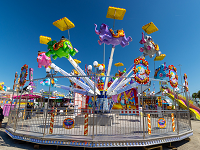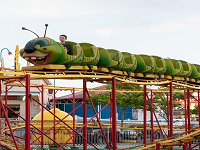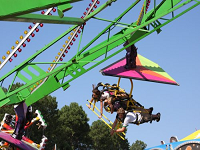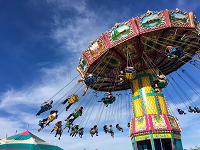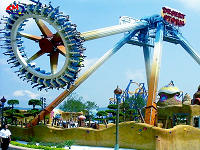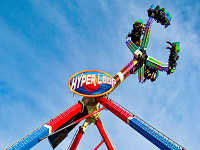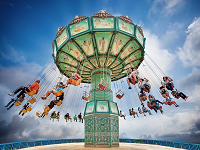What Is Amusement Equipment And What Amusement Rides It Is Included?
What Is Amusement Equipment?
Amusement Equipment are equipment that people use to achieve entertainment and fitness purposes and use the principles of machinery, electricity, light, sound, and water to provide tourists with games and entertainment.
Its development stage can be divided into the stage of coexistence of amusement machines and amusement facilities according to the advanced technology and equipment structure used, and the stage of amusement facilities which are collectively referred to now.
After the amusement facilities were listed as special equipment, the concept of large-scale amusement facilities was proposed. For their specific definitions, relevant regulations and standards have been specifically and clearly stated.
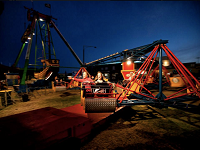
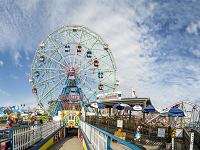
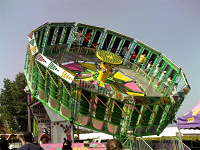
Definition from <ride terms>
(1) Amusement Device is a device or facility for people to entertainment.
(2) Large-scale amusement Equipment are used for business purposes and carry tourists for amusement, and the scope is specified as the maximum operating linear speed greater than or equal to 2m/s, or the operating height is higher than or equal to 2m from the ground. Large manned rides.
(3) Small amusement equipment are used in public places and carry children’s amusement equipment, and do not belong to the large-scale amusement facilities specified in the “Special Catalogue”. Such as slides, swings, rocking horses, seesaws, climbing nets, swivel chairs and other recreational facilities.
(4) Traveling amusement Equipment is an amusement device that has no special civil foundation and is easy to disassemble, move and transport.
(5) Have power type of amusement equipment is a facility driven by human power, electric power, internal combustion engine or steam engine, which carries tourists for amusement.
(6) No power type of amusement equipment is a kind of amusement equipment that tourists do not need to drive by power, and are operated or entertained by passengers.
(7)Water amusement equipment is a water facility built for recreational purposes by means of water, currents or other carriers.
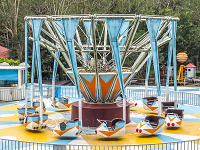
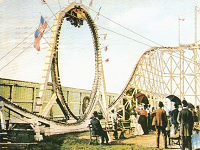
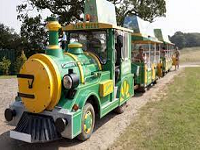
Definition of Relevant Amusement Equipment in “Special Equipment Safety Supervision Regulations”
(1) Special equipment refers to the mechanical equipment that involves life safety and is more dangerous as stipulated by the state. These mechanical equipments include boilers, pressure vessels (including gas cylinders, the same below), pressure pipes, elevators, hoisting machinery, passenger ropeways, large amusement facilities and special motor vehicles in the field (factory).
(2) Large-scale amusement equipment is a manned amusement facility that is used for business purposes and carries tourists for amusement. The designed maximum operating linear speed is greater than or equal to 2m/s, or the operating height is higher than or equal to 2m from the ground.
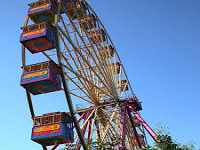
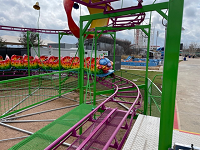
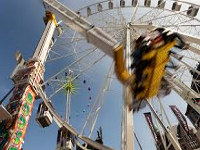
What is the function and composition for amusement equipment?
(1) Function: The main function of amusement facilities is entertainment, and some amusement facilities also have the function of fitness.
(2) Composition: There are many kinds of amusement facilities, which are typical mechatronic products. Amusement facilities are mainly composed of mechanical, structural, electrical, hydraulic and pneumatic components. Among them, the machinery is used to realize the movement, the structure is used to solve the bearing capacity, the electricity plays the role of control and drag, and the hydraulic pressure and air pressure are another way to realize the transmission.
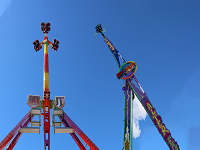
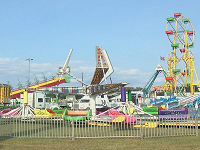
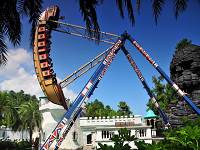
Although amusement equipment have different structures and movement methods, different sizes and appearances, common amusement facilities are mainly composed of the following parts.
1) Basic part: the foundation, the feet, the foot and so on.
2) Support part: it consists of pillars, beams, etc.
3) Drive part: composed of electric power, internal combustion engine, manpower, etc.
4) Transmission part: mechanical transmission, hydraulic transmission, pneumatic transmission and other components.
5) Operation part: cockpit, gear train, rotating arm, etc.
6) Operation part: composed of operation room, operation table, operation handle, etc.
7) Control part: control system, control program, control components and other components.
8) Decorative part: Appearance decoration, lighting and other components.
9) Turntable part: composed of passenger platform, passenger stairs, etc.
10) Isolation part: composed of safety fence, transition fence, etc.
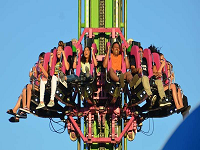
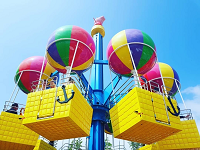
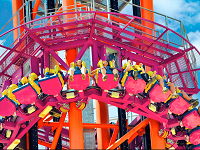
What is the feature of the Amusement Equipment
In order to fully reflect the various functions of amusement equipment, it is very important to scientifically design various technical parameters of amusement equipment. These technical parameters are the basis for the design, use and management of amusement equipment. “Terms of Amusement equipment” (GB/T20306-2017) makes the following descriptions and definitions for the main parameters of amusement equipment:
(1) Circumferential velocity ; Under the action of rated load, the speed in the tangential direction of the rotation of the passenger part (outside of the cockpit) of the amusement equipment around the central axis is called the circumferential velocity.
(2) Traveling speed; an amusement machine traveling along a specified track or ground, the speed at which it travels under the rated load is called the running speed.
(3) Lifting and lowing speed: Under the action of rated load, the vertical upward and downward displacement speed of the passenger part of the amusement machine is called the lifting speed.
(4) Lifting speed; Along the track with a slope, the running speed of pulling the amusement machine upward by external force is called the lifting speed.
(5) Traveling altitude ;The height of the passenger part from the boarding platform or the ground during the operation of the amusement machine is called the running altitude.
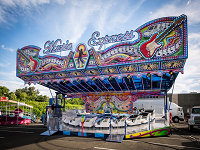
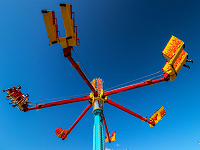
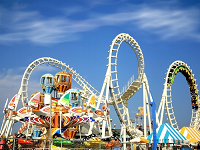
(6) Swing angle ;The angle between the center line of the passenger part of the amusement equipment and the vertical center line is called the swing angle.
(7) The tumbled rides with an angle greater than 360° when the passenger part is running are called tumbling.
(8) Acceleration factor ; During the operation of the amusement machine, the ratio of the instantaneous acceleration to the acceleration of gravity is called the acceleration factor.
(9) Dynamic load factor ;During the operation of the amusement machine, the ratio between the actual dynamic load (real working condition) and the static load is called the dynamic load factor.
(10) Big jib angle; When the end of the boom of the amusement machine rises to the highest point, the angle between the axis of the boom and the horizontal plane is called the boom angle.
(11) Gondolas depth; The height from the pedal surface of the non-enclosed cockpit of the amusement equipment to the top surface of the cockpit (or the top surface of the handrail) is called the depth of the cockpit.
(12) Chair-back height;The distance from the seat surface of the non-enclosed cockpit seat of the amusement equipment to the top surface of the backrest is called the seat back height.
(13) Seat net width; The effective width of the cockpit seat of the amusement equipment is called the seat net width.
(14) Cars minimum turning radius; When the vehicle carrying the amusement equipment turns, the minimum arc radius of the outer running track of its front outer wheel (four wheels) or front wheel (three wheels) is called the minimum turning radius of the vehicle.
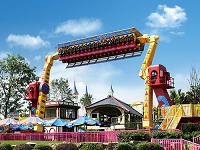
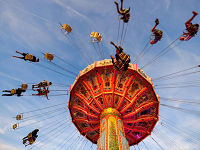
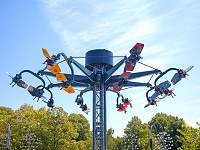
(15) Braking distance ;The distance from the start of braking to the stop of the amusement equipment is called the braking distance.
(16) Wheel load ; The maximum vertical load transmitted by the wheels of the amusement ride to the track or the ground is called the wheel load.
(17) Track gauge ;The distance between the centerline of the two tracks or the centerline of the tread of the walking wheel is called the wheel gauge.
(18) Track curvature radius ;The curvature radius of the inner rail of the double track or the inner side of the single track of the curved segment of the amusement equipment vehicle running line is called the track curvature radius
(19) Lane (track, skidway, pavement) slope ;The slope of the lane is the ratio of the climbing height of the vehicles carrying the amusement equipment to the length of the slope, and its calculation formula is i= h/B, where: i is the slope; B is the length of the ramp section; h is the climbing height (the length of the corresponding ramp section).
(20) Average inclination of summer toboggan run; The ratio of the total elevation difference of the amusement equipment slide to the horizontal projection of the total length of the slide is called the average slope of the slide.

